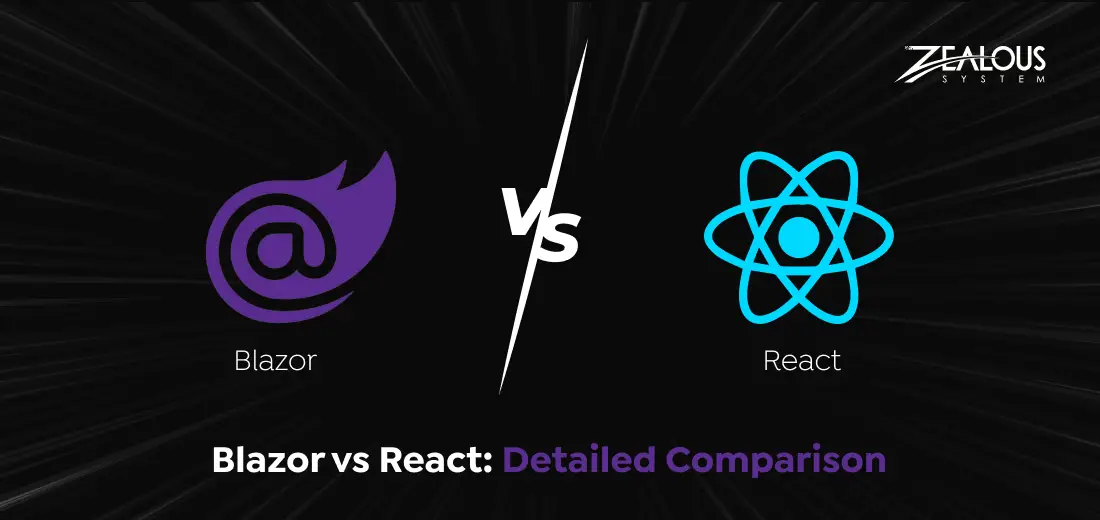


When it comes to building websites and web apps, choosing the right framework can make all the difference. As we head into the middle of 2024, two frameworks are standing out: Blazor and React.
Blazor is part of ASP.NET Core and lets developers use C# and .NET to create web user interfaces, without needing to rely heavily on JavaScript.
React, on the other hand, is a popular choice from Facebook, known for its component-based approach and fast rendering with something called the virtual DOM.
Both frameworks have their strengths and weaknesses, so picking the right one is crucial. Let’s take a closer look at Blazor vs. React to help you decide which one might be best for your next project.
Let’s understand:
Blazor is a powerful open-source web framework that empowers developers to build web applications using C# and HTML. By seamlessly combining C# with HTML and CSS, Blazor allows you to create rich web UIs for client-side applications written in .NET. These apps are launched as web assemblies, ensuring smooth operation across all browsers without the need for third-party plugins, offering complete independence on the user platform.

Blazor Server and Blazor WebAssembly are two hosting types offered by Microsoft’s quick, dependable, and highly productive open-source online development framework to simply handle client-side and server-side applications.
By now, it should be clear that Blazor is a direct rival to JavaScript Single Page Applications (SPA) and uses HTML rather than JavaScript. Let’s now see some of Blazor’s standout characteristics.
Blazor’s component-based architecture is one of its standout features. This approach allows developers to create reusable components, enhancing the efficiency and maintainability of their code. With Blazor, you can easily leverage this feature to build dynamic and interactive web applications.
Another key feature of Blazor is its use of a virtual DOM. This technology allows Blazor to update the UI with minimal re-rendering, resulting in faster rendering times and a smoother user experience. By leveraging this feature, developers can create highly responsive web applications with ease.
Blazor’s seamless integration with JavaScript is a game-changer for developers. This feature allows you to use existing JavaScript libraries and code in your Blazor applications, making it easier to work with existing projects and tools. With Blazor, you can use the JavaScript frameworks while enjoying the benefits of C# and .NET development.
Blazor offers two hosting models, including server-side Blazor and Blazor WebAssembly. This flexibility allows developers to choose the hosting model that best suits their application’s needs. With Blazor, you can easily deploy your application to the hosting environment of your choice, ensuring optimal performance and scalability.
Blazor benefits from a rich ecosystem of tools, libraries, and community support. This vibrant community is constantly contributing new ideas, libraries, and solutions, making it easier for developers to build complex applications with Blazor. By leveraging this feature, you can tap into a wealth of resources to enhance your Blazor development experience.
Blazor applications are compatible with a wide range of platforms, including Windows, macOS, and Linux. This cross-platform compatibility makes it easier for developers to reach a broader audience with their applications. With Blazor, you can build once and deploy everywhere, ensuring maximum reach for your web applications.
Blazor’s unified development approach with C# and .NET is a standout feature. This approach streamlines the web application development process and allows developers to use their existing skills and libraries. With Blazor, you can easily create interactive web UIs using familiar tools and technologies, making development faster and more efficient.
Here are some of the pros and cons of blazor that every developer must know:
Full-stack Development: Blazor allows developers to use C# for both client-side and server-side development, streamlining the development process and reducing the need to switch between different languages and frameworks.
React is one of the most popular JavaScript library used for building user interfaces. It follows a component-based architecture, where developers create reusable components to build complex UIs. React uses a virtual DOM to efficiently render UI components, updating only the necessary DOM elements when changes occur.
This leads to improved performance and a smoother user experience. React also supports JSX, which allows developers to write HTML-like code directly in JavaScript, simplifying the UI components development and making the code easier to read.

Here are the top features of React that make it a popular choice among developers:
React is built around the concept of reusable components, allowing developers to break down the user interface into smaller, manageable parts. This promotes code reusability, modularity, and easier maintenance.
Another great feature of React is that it utilizes a virtual DOM (Document Object Model), which is a lightweight copy of the actual DOM. This virtual representation allows React to efficiently update the UI by only re-rendering the components that have changed, resulting in faster performance and smoother user experiences.
JSX is a syntax extension for JavaScript that allows developers to write HTML-like code within their JavaScript files. This declarative syntax makes it easier to create and visualize UI components, improving code readability and productivity.
React follows a unidirectional data flow, also known as one-way data binding. This is an awesome feature of React, which makes the data flows in a single direction, from parent components to child components. This simplifies data management and ensures predictable behavior, making it easier to debug and maintain large-scale applications.
Another key feature of React is that it provides a set of lifecycle methods that allow developers to hook into different stages of a component’s lifecycle, such as initialization, mounting, updating, and unmounting. This allows developers to perform actions like fetching data, updating state, or cleaning up resources at specific points in a component’s lifecycle.
Introduced in React 16.8, hooks are functions that allow developers to use state and other React features without writing class components. Hooks provide a more concise and functional approach to managing component state and side effects, making code more modular and reusable.
React has a big ecosystem of tools, React libraries, and community support, including popular libraries like Redux for state management, React Router for routing, and Material-UI for building UI components. This rich ecosystem empowers developers to build scalable, feature-rich applications with ease.
These key features make React a powerful and flexible framework for building modern web applications, allowing developers to create dynamic, interactive user interfaces with speed and efficiency.
Even after being the most popular choice among developers, React has its own share of advantages and disadvantages. Here are few:
This comparison table highlights the key differences between Blazor and React, helping you make an informed decision based on your project requirements, team expertise, and desired outcomes.
| Feature | Blazor | React |
|---|---|---|
| Language | C# | JavaScript (with JSX) |
| Framework | Part of ASP.NET Core framework | Standalone framework |
| Rendering | Server-side (with SignalR) or Client-side (WebAssembly) | Client-side (Virtual DOM) |
| Performance | Good performance, especially with Server-side rendering | Excellent performance with Virtual DOM |
| Learning Curve | Steeper for developers new to C# and ASP.NET | Easier for developers familiar with JavaScript |
| Community Support | Growing community, but not as large as React | Large and active community |
| Integration | Integrates well with other .NET technologies | Integrates with various JavaScript libraries and frameworks |
| Componentization | Blazor components can be more self-contained and easier to manage | React components offer high reusability and modularization |
| Performance Tuning | Allows for fine-tuning performance optimizations in both server-side and client-side scenarios | Offers tools like React DevTools for analyzing and optimizing performance |
| Learning Resources | While growing, may have fewer tutorials and learning materials compared to React | Abundance of tutorials, documentation, and community resources for learning |
Now that we have seen the notable differences between Blazor and React, let’s explore how to choose between React and Blazor for application development.
Deciding whether to use React or Blazor boils down to a few key considerations:
Consider these factors when deciding between React and Blazor, and choose the framework that best fits your project’s needs and your team’s skills.
Blazor and React both offer powerful features for web application development, each with its own set of advantages and challenges. By understanding the differences and evaluating your project needs, you can choose the framework that best aligns with your goals.
Whether you opt for Blazor’s robust .NET integration or React’s extensive ecosystem and performance, both frameworks provide the tools needed to build modern, efficient web applications. If you need expert assistance, consider partnering with a React development company or hire a React developer in India to ensure your project’s success.
Our team is always eager to know what you are looking for. Drop them a Hi!
Comments